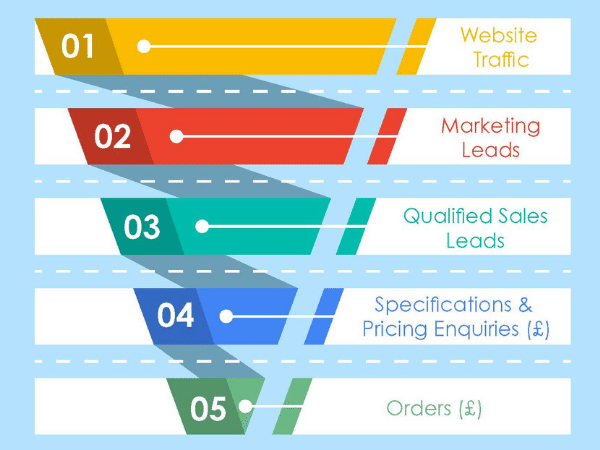
The ‘news’ or ‘blog’ section is often an underused asset on many building product websites, but when its powers are harnessed, it can yield some lucrative results for your business.
In fact, one of our clients received a 58% increase in quotations as a result of blogging*. If anything, this just highlights your missed opportunities if you don’t start taking blogging – or content marketing in general – seriously.
That’s right; In a world where the majority specifiers are conducting product research online, updating your website consistently with useful content will ensure you stay on top of the search results.
So, if you’re thinking about starting blogging, or if you’ve tried before but failed to see the results, give this post a read and find out what your building product blogs should be used for.
Read on…
*How can you attribute blogging to enquiries, I hear you ask… With HubSpot CMS, you can attribute every online enquiry back to a user’s behaviour on your website. Get in touch to find out more.
To Improve Your Rankings
Your blog should be used to improve your website rankings. This means that they should be optimised for SEO. If your blogs don’t fulfil this fundamental aim, you will end up wasting a heck of a lot of time.
So, how can blogging improve rankings?
Sadly, it’s not an overnight win and it does require an understanding of SEO in order to get the most out of it.
Before beginning to blog, you should carry out keyword research to identify what search terms people are using to find solutions similar to the ones you provide.
Secondly, you should choose one topic and stick to it. In other words, write a series of blogs around one topic, whether it’s:
- Fire doors in apartment buildings
- LST radiators in schools
…Or any other topic that’s relevant.
That way, Google will recognise that you’re an authority in a particular area, giving you more of a chance to be ranked on page 1 of its search results.
To Provide Value
SEO aside, blogging must also provide value to your potential customers.
There’s no use writing about topics that your key audience won’t find interesting or useful.
Your blogs should shed light on a particular issue; they should serve up information that helps specifiers to do their job better and makes their lives easier – even if that means presenting technical information in a digestible way.
If you’re operating in a competitive space, you should always ask yourself,
Can they find this information elsewhere?
If the answer is yes, you’re probably not providing value.
Always aim to provide a unique perspective to a conversation.
To Nurture Leads
Research suggests that building product companies focus too much of their efforts on ‘bottom of the funnel content’. In other words, closing the deal.

If your website isn’t set up to attract organic traffic, you could be losing out big time.
Blogs are aimed to attract top of the funnel visitors, i.e. organic leads. This type of content will allow you to build trust with a steady stream of new, organic specifiers to your website. This type of lead nurturing is proven to increase client retention, as opposed to companies who are too intent on the sale.
Provide Useful Content For Other Platforms

When was the last time you went to write a social media post or sent a marketing email only to realise you haven’t got anything to talk about…?
Blogs don’t just have to sit in your website’s news section. They can be shared across a variety of platforms, sparking discussions on LinkedIn, for example.
Creating an email newsletter with your latest blog content will also ensure that your contacts get access to your insightful knowledge bank straight in their inbox.
Bottom line: blogs shouldn’t sit stagnant in your news area. Squeeze them for all their value and share them across a variety of platforms.
As A Sales Tool
Blogs should be there to answer common queries or debunk misconceptions that prospects might have. By working closely alongside your sales team, you could identify a series of key questions that your sales team get asked on a regular basis and answer them via a blog post (or series of posts).
That way, instead of your sales reps having to repeat the same words over and over again, they can point prospects in the direction of a blog post instead.
We know sales reps like the sound of their own voice, but this will guarantee to make their job easier and conversations more meaningful.
What Shouldn’t Your Building Product Blogs Be Used For?
We’ve discussed the good; now we’ll address the bad… and the ugly. We see a lot of bad practice when it comes to blogging, so save yourself the pain and misery, and don’t commit these cardinal sins.
Self-promotion
We are proud to announce…
We’ve secured this prestigious project…
Phrases like this serve no purpose to specifiers carrying out product research.
That’s not to say you can’t celebrate your wins, but they should be done in a way that isn’t too self-promotional. Projects should be housed on your case study section and announcements could be used on email newsletters.
Blogs, should be used as insightful articles to help make the lives of your specifier easier and shameless self-promotion won’t impress your audience.
Bad-mouthing the competition
When you run-down competitors in your blogs, it comes across unprofessional and biased towards your offering. This should be avoided; a balanced overview is what you should aim for.
Biased views
Leading on from my previous point, your blogs shouldn’t be biased. In fact, they should be objective. Be clear on what your product/solution can’t do as well as what it can do.
People tend to see through one-sided viewpoints.
Misleading/Exaggerated Info
If any content is misleading or exaggerated, you’re oping yourself up to a whole host of issues down the line. Phrases like,
…our products will stop users from slipping on the floor’s surface.
Should be replaced with…
…Anti-slip technology will reduce the risk of users slipping on the floor’s surface.
Conclusion
To recap, blogs should be used to:
- Improve rankings
- Provide value
- Nurture leads
- Provide useful content to other platforms
- Be used as a resource for your sales team
Get these things right, and you could be on your way to reaping the benefits of blogging for your building product business.
If you’d like to find out more about how Insynth can help you with your content marketing efforts, don’t hesitate to speak to an expert today.
About Insynth
At Insynth we deliver a predictable flow of leads, customers, and specifications for building product brands through our inbound marketing approach, proven to reach a technically demanding audience.
We use the latest marketing techniques such as construction inbound marketing, to equip building product companies to grow sustainability in this era of digital transformation.
As the only HubSpot certified agency to major in construction marketing. We have a proven formula of bringing a variety of functionalities together including CRM Implementation, Web Design, Sales Automation, SEO, and Email Marketing to achieve your ultimate aim: Growing your business and gaining new specifiers and customers.

